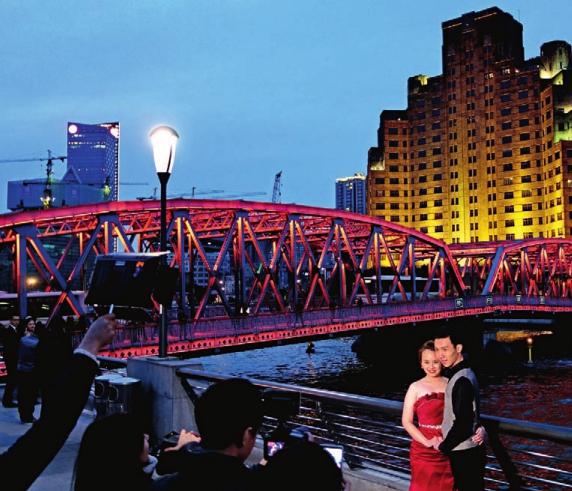Shanghai’s Metropolitan Magnetism

LOCATED at the mouth of the Yangtze River, Shanghai has grown from a small fishing village with just a few roads and a limited number of residents some 700 years ago to a glamorous international metropolis. If, as Johann Wolfgang von Goethe mused, “architecture is frozen music,” then Shanghai is an eternal concert. Buildings in this city, renowned at home and abroad, have witnessed the vicissitudes of society, and it is through architecture that one can best understand this city.
A Fair of the Worlds Architectures
In the past century, an ethos of commingled local Shanghai culture and modern Western trends has taken shape in the city. Its structures often showcase diversifi ed yet distinct styles – traditional Chinese, exotic, or a combination of both – so engendering a fair of the worlds architectures.
The Bund stands out among all Shanghais attractions. Metropolises always vaunt their particular showpieces, and the Bund is defi nitely the pride of Shanghai.
Extending for more than 1,500 meters from East Yanan Road in the south to the banks of the Suzhou River in the north, the Bund is host to a collection of constructions in various styles, such as neoclassicism, renaissance, and Baroque, to name just a few.
The confluence of the Suzhou River and the Huangpu River is deemed the cradle of Shanghai culture and the origin of the Bund. Here are stored the memories of old Shanghai. Well-preserved red brick walls and elegantly carved balustrades evoke 20th-century Shanghai. Waibaidu Bridge stretching over the Suzhou River is the first riveted steel bridge in China, representing the progress of modernity and the industrialization of Shanghai at the time it was built. In 2008, the 100-year-old bridge was detached for a thorough restoration. It was replaced one year later and continues to serve its purpose of handling heavy traffi c.
The Peace Hotel situated on the Bund was the citys first structure built in the style of the modernist school. Built in 1929 and first known as the Cathay Hotel, the northern wing was owned by Jewish businessman Victor Sassoon. The Gothic construction, with its distinctive green pyramid-shaped roof, is 77 meters high and has 12 floors. The Sassoon Presidential Suite on the top floor is where the owner used to live.
The headquarters of todays Shanghai Pudong Development Bank is located in the former HSBC building on the Bund. Called “the most luxurious building from the Suez Canal to the Bering Strait”in the 1930s, the construction is a masterpiece of classical architecture in modern China. Eight large mosaic murals originally adorned the enhance hall of the buliding. The dome was decorated with frescos depicting the signs of the zodiac, Apollo, and Luna. However, they were covered when the bank closed this branch office in the 1950s and were not discovered until November 1997.
A total of 23 old buildings on the Bund have survived historical changes and present the citys glorious past. An enjoyable evening can be spent on the Bund riverbank taking in the magnificent cultural heritage illuminated by resplendent lights. When night falls, a ferry trip on the Huangpu River will offer yet another perspective from which to enjoy the Bund.
Down-to-Earth Alleys
Streets are the blood vessels of a city. Criss-cross networks of streets and roads are key components of Shanghai. A birds-eye view shows that the city is divided into a good number of districts through arteries. Inside those districts, narrow alleys between buildings spread all over the city like capillaries –miniscule but full of energy. Such alleys, like hutong in Beijing, present peoples everyday life and preserve the local culture.
Shikumen buildings are always associated with these alleys. Shikumen, literally “stone gate,” is an old form of residence with brick-wood structures and stone gates. Rows of Shikumen buildings constituting alleys have become a symbol of traditional Shanghai residences.
Residents of alleys usually come from all walks of life, which diversifies the community atmosphere. Here you may find that neighbors are always kind to each other and willing to help one another. When Shanghai first boomed some 100 years ago, considerable numbers of people left their hometowns to venture into this promising city. For those who are away from home, a neighbor that is near is better than a brother far off. Therefore, neighborhoods in the alleys were as close as family members, a trend that is fading today. Life in alleys often brings a sense of place, safety, and kinship. Undeniably, privacy is a rare luxury in these narrow and small dwelling spaces. Sometimes, family life is unavoidably exposed to the entire community.
However, alleys that have existed in this city for more than 100 years are starting to disappear. Residents in the alleys downtown are moving out one after another and reconstructions are widely carried out in the city. Old conventions and traditional culture are being replaced by new lifestyles. In recent years, renovations have been launched to protect time-honored Shikumen buildings by merging modern elements with traditional architectural styles.
Pudong – the Citys New Face
Modern skyscrapers on the eastern bank of the Huangpu River stand in stark contrast to the historical architecture on the Bund. With the most up-to-date buildings and booming development, Lujiazui Financial District in Pudong is another of Shanghais highlights displaying world-level competence. Pudong, literally “the east bank of the Huangpu River,” was established as a new area of Shanghai in 1993. Before it infuses into the Yangtze River, the Huangpu River flows through Shanghai and divides the city into western and eastern parts. Despite its short history, the Pudong New Area has grown into the most populous administrative district of Shanghai. It has also become the citys largest administrative district since the former Nanhui District merged into Pudong in 2009.
Standing at the forefront of Chinas reform and opening-up, Pudong plays a key role as Shanghai aims to build itself into an international finance and shipping center. The countrys first pilot free trade zone was built in Pudong in 2013. At the same time, new highrises constantly mushroom in this area. There is a long list of Pudongs remarkable landmarks: the Oriental Pearl Radio & TV Tower, Jinmao Tower, Shanghai Tower, Shanghai World Financial Center (SWFC), Shanghai International Convention Center, Super Brand Mall, Oriental Art Center, and Shanghai Science & Technology Museum, to name a few.
Banks such as Standard Chartered, Citibank, Fortis, and BayernLB opened branches on the Bund and witnessed the legends of the city in the 1930s. Today, Shanghai is still a stage for financiers to show their talent. BEA China, Citibank China, Bocom Financial Building, and a good number of plazas are adding to the metropolis contemporary glamor. In a sense, the Huangpu River flows right between history and modernity. So why not have a cup of coffee in the park on the riverbank and feel the changes of this financial center over the past 100 years.
The west and east riverbanks are connected by Yangpu Bridge and Nanpu Bridge which look like two dragons crouching on the Huangpu River. The two sides of the city, each with their traditional and modern characteristics, jointly enhance Shanghais image as a fascinating international metropolis.

